Side Menu:
Second Officer David Blair
- R.M.S. Ttianic
37-year-old David Blair joined Titanic's senior officers in late March, prior to the arrival of the junior officers (Pitman, Boxhall, Lowe and Moody) on the 27th. For both Blair and Lightoller arriving from smaller ships, Titanic was very impressive. Lightoller later wrote that it "is difficult to convey any idea of the size of a ship like the Titanic, when you could actually walk miles along decks and passages, covering different ground all the time... it took me fourteen days before I could with confidence find my way from one part of that ship to another by the shortest route."

Titanic's 'Particulars of Engagement' in Belfast lists Blair as Second Officer (third line) underneath Chief Officer William Murdoch and First Officer Charles Lightoller.
(Image: Public Record Office/Nicola Foster)
(Click image to enlarge)
Sea Trials
Titanic's sea trials, abbreviated due to weather conditions, took place on the 2nd of April, 1912, and Blair, as second officer, would have been stationed on the forecastle with the Chief Officer - William Murdoch - during its departure from Belfast. One of the unpublished photographs of Titanic at Belfast is her poised by the East Twin Island light tower, prior to her run into the open sea, 2nd April 1912, published in Titanic Unseen: Titanic and Her Contemporaries. According to its author Senan Molony, this photograph includes Chief Officer Murdoch (prior to his demotion to First officer on April 10, 1912), standing with his back to the rail on the forecastle of the ship. Molony explains: "It was the Chief Officer's duty in the White Star Line to be on the fo'c'sle when leaving port. Murdoch held this role until Southampton. It's also his build and stance and he's the sole officer there." The other figure with him would almost undoubtedly be David Blair.
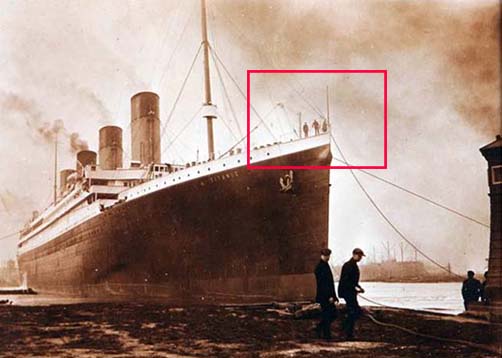
Titanic at Belfast poised by the East Twin Island light tower, 2nd April 1912. On the forecastle is an officer and crew member (red box).(From the Kempster Album. By kind permission of Steve Raffield, supplied by Senan Molony.)
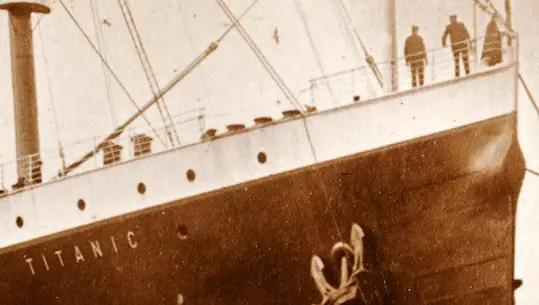
In this close-up from the above photograph we can see an officer, most likely Murdoch (centre) on the f’o’c’sle. It was the Chief Officer's duty to be on the f’o’c’sle when leaving port, along with the Second Officer - so the other figure could indeed be Second Officer David Blair. (From the Kempster Album. By kind permission of Steve Raffield, supplied by Senan Molony.)
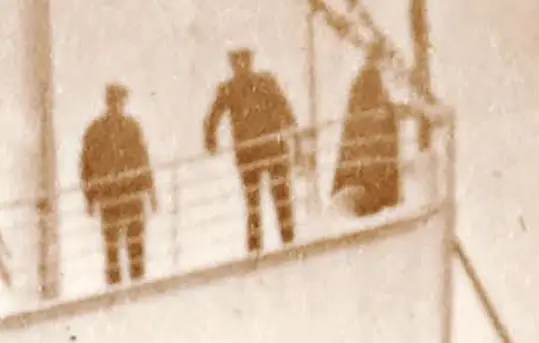
In this extra close-up from the above photograph we can see an officer (centre) does indeed bear a likeness to William Murdoch, while the other figure on the left could be Second Officer David Blair. (From the Kempster Album. By kind permission of Steve Raffield, supplied by Senan Molony.)
According to a menu Lightoller kept as a souvenir, the senior officers enjoyed a lunch including consommé mirrette, sweetbreads and spring lamb.
With all tests meeting the Board of Trade standards, the Titanic sailed that very night at 8pm destined for Southampton, her port of embarkation, arriving on April 3rd. According to Lightoller's British Inquiry evidence, "from Belfast round to Southampton we averaged about 18 knots... Perhaps 18 ½’ I do not think she got much higher than that."(24.)
Southampton
Upon arriving in Southampton there was a week of intense activity to prepare the ship for its maiden voyage. Blair wrote on the 4th of April that he had "been home all day and down on board tonight on watch." It seems the Blair family had accommodation in Southampton at the time. But there was work to be done. Henry Wilde, onboard by the 7th of April, later wrote that he had been working hard to get Titanic ready for sailing day "I have been kept very busy on board all day on Good Friday and again today Sunday with the crew getting the ship ready. She is very far behind to sail on Wednesday. Working on her night and day." Lightoller also described how Titanic was 'heeled for stability' and signing on of crew.
But there was enough time for Blair to entertain guests - as Chief Officer William Murdoch described when he invited his wife Ada aboard on the 8th of April. According to Blair's daughter Elizabeth's 1958 letter:
"We were living in Southampton at the time +, although I was too young then to remember anything about it, I have heard my mother say that she had tea on board the day before the sailing + there was still work people racing to finish the laying of carpets etc. in time. My aunt has told me that my father showed her all over the ship + it took them three hours to go round, she was so large." (Elizabeth Blair, to Walter Lord, 11/10/58, courtesy of Paul Lee)
Blair "bumped" - the Reshuffle
There must have been some knowledge that one of the senior officers would have to be "bumped" before sailing day. As early as the 30th of March 1912 Henry Wilde knew he was joining Titanic, writing to his daughter while aboard Olympic: "I am not sailing in this ship on Wednesday but going to join the Titanic. All arrangements are upset now owing to the coal strikes." (Sincerely Harry, Michael Beatty (63.)
By the 7th of April he was onboard Titanic and two days later, at 2pm on the 9th of April 1912 was informed by telegram that he was indeed to become Chief Officer aboard Titanic on sailing day. This resulted in a reshuffle of the senior officers - Murdoch dropping from Chief to First, Lightoller First to Second and Blair removed entirely. Lightoller later wrote in his autobiographical book "Titanic and Other Ships": "I stepped back on Blair's toes, as Second, and picked up the many threads of his job, whilst he - luckily for him as it turned out - was left behind."

This Board of Trade 'Report of Survey' document shows the officer reshuffle.
While the "reshuffle" arguably saved Blair's life he was of course disappointed at the time. In a picture postcard sent to his sister-in-law in Scotland, dated 11pm April 4th, 1912, Blair wrote: "Am afraid I shall have to step out to make room for chief officer of the Olympic. This is a magnificent ship, I feel very disappointed I am not to make her first voyage". It is interesting to note the date - April 4th, 5 days before Wilde would receive an official telgram appointing him to the position. It must have been widely known among the officers that this would happen, rather than an unexpected, last minute decision.
4th, Southampton |
Elizabeth Blair in her 1958 letter to Walter Lord notes that the word "very" was underlined: "I have a picture postcard of the ship which he sent to his sister-in-law + on it he said "I feel very [underlined] disappointed I am not to make the first voyage ... I hope eventually to get back to this ship."" (Elizabeth Blair, to Walter Lord, 11/10/58, courtesy of Paul Lee)
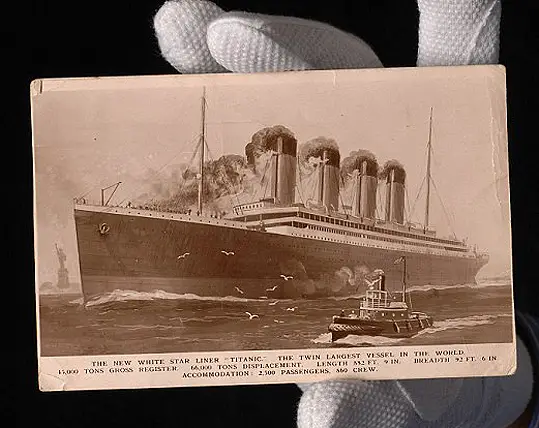
The picture postcard Blair sent to his sister-in-law in Scotland
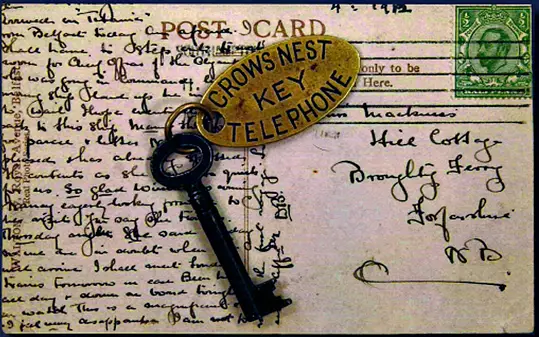
In the postcard he wrote; "I feel very disappointed I am not to make her first voyage"
So when Titanic departed at midday on the 10th of April 1912, Blair was no longer aboard in his role of Second Officer. He perhaps watched her depart. In April 2007, Sheila Jemima, one of the authors of the book "Titanic Voices" gave a talk in Southampton, in which she said that a figure in the famous photograph of Titanic departing her berth is in fact David Blair. Paul Lee notes: "They had blown up the original negative to help in making this determination. I assume that they had a photograph from Blair's family to make the identification - after all, they had loaned Southampton City Council the Blair keys to place in their maritime museum so there was some contact between the two parties." (http://www.paullee.com/titanic/eblair.html)
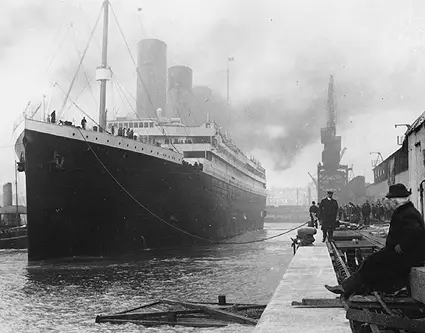
Titanic departing Southampton docks, with a figure walking towards camera. See below for close up.
(Click image to enlarge)
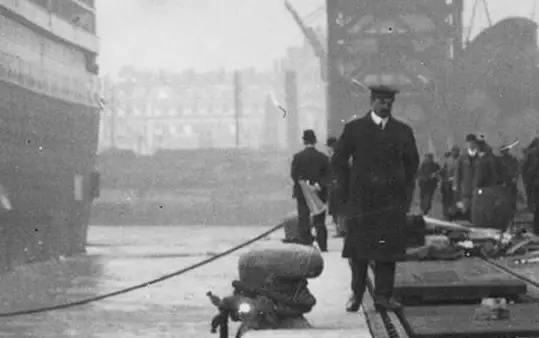
A close up of the above photograph of the man walking towards camera. According to Sheila Jemima, one of the authors of the book "Titanic Voices," this is David Blair.
Blair - the "Man Who Sank Titanic"?
When David Blair departed from Titanic on the 9th of April, he accidentally took with him an iron key, with a brass oval tag attached that reads "Crows Nest Telephone Key."
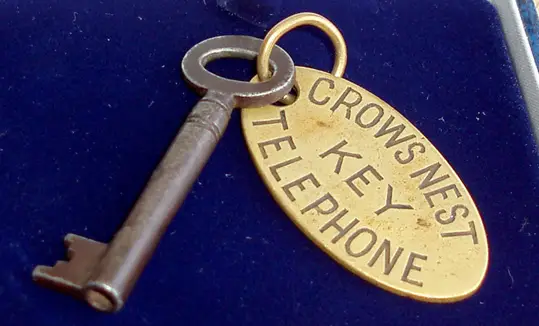
Blair's iron key, with a brass oval tag attached that reads "Crows Nest Telephone Key."
Later, this seemingly insignificant act was expanded to accuse Blair of being the 'man who sank Titanic.'
The story most likely has its origins in testimony by lookout George Hogg following the sinking. Hogg testified at the British Inquiry that on the trip from Belfast to Southampton, the lookouts had been loaned by Blair a pair that were marked “SECOND OFFICER, S.S. TITANIC.” Upon Titanic’s arrival at Southampton, Blair had been in the crow’s nest using the binoculars himself. (When docking the ship, each officer had an assigned station, and the crow’s nest position was assigned to the Second Officer.) During the British Wreck Comissioner's Inquiry (Day 15), 29-year old lookout George Hogg described how he had been given a "pair of glasses" (binoculars) by Blair when Titanic was docked in Southampton, who later locked these glasses in Blair's Second Officer's cabin with a key which was then returned to Blair
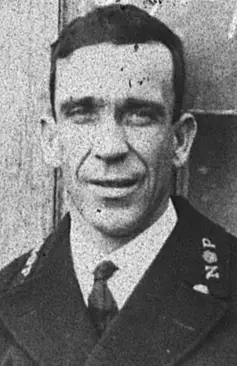
Lookout George Hogg described how
he had been given a "pair of glasses"
(binoculars) by Blair when Titanic
was docked in Southampton
17494. Do you remember when the "Titanic" was leaving Belfast - you signed on the "Titanic" as look-out man, we know - were a pair of glasses given you?
- Yes.
17495. For the crow's-nest?
- Yes.
17496. Who gave them to you, do you remember?
- Mr. Blair, the acting Second Officer then.
17497. Mr. Blair, who was then acting as Second Officer?
- Yes.
17498. Did you notice how they were marked?
- "Theatre, Marine and field." "Second Officer, S.S. 'Titanic.'"
17499. That was on one side, was it?
- Yes.
17500. Was "Theatre, Marine, and field" the same?
- No, you worked them as you wanted to use them.
17501. When you left the ship at Southampton, what did you do with those glasses?
- Mr. Blair was in the crow's-nest and gave me his glasses, and told me to lock them up in his cabin and to return him the keys.
17502. Who returned the keys?
- I gave them to a man named Weller, as I was busy on the forecastle head.
17503. As far as you were concerned, the glasses, you were told, were to be locked up in the cabin of the second Officer?
- I locked them up.
17504. And they were locked up. When the ship left Queenstown were there any glasses in the crow's-nest?
- There were none when we left Southampton.
17505. Did you ask for them?
- Yes.
17506. When you left Southampton?
- I did not exactly ask for them, but my mates asked for them at that time.
17507. Did you ask for them at all after you left Queenstown?
- After I left Queenstown.
(Testimony of George a. Hogg, British Wreck Commissioner's Inquiry, Day 15)
Blair was in the Crows Nest due to that location being an assigned station for the Second Officer when docking the ship, according to Titanic researcher Art Braunschweiger (Source: https://www.encyclopedia-titanica.org/we-have-no-look-out-glasses-in-the-crows-nest.html)
Blair’s crows nest key remained in his possession until his death. His daughter Elizabeth then donated it to the International Sailors Society. It was then it put up for sale by auctioneers Henry Aldridge, in Devizes, Wiltshire.
At the time, auctioneer Alan Aldridge, said: "We think this key is one of the most important artefacts from the Titanic to have come to light. Blair was the second officer. He had the key, which we believe was for the binoculars' locker ... it is the key that had the potential to save the Titanic." (The Guardian, Wed 29 August 2007)
The description caused the media to take note and resulted in the following headlines:
Is this the man who sank the Titanic by walking off with vital locker key? (Evening Standard, Tuesday 28 August 2007)
Key that could have saved the Titanic goes up for auction (The Guardian, Wed 29 Aug 2007)
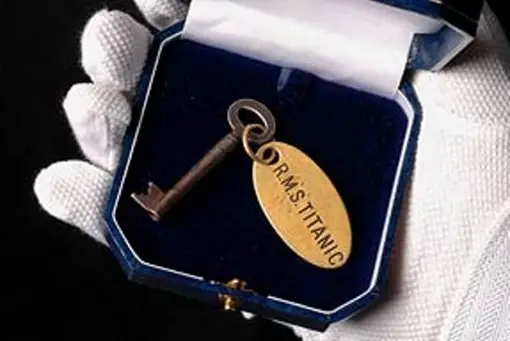
The other side of Blair's key has the name RMS Titanic
The actual auction listing is as follows:
RMS Titanic: Second Officer David Blair OBE. Iron key with brass oval tag attached "Crows Nest Telephone Key". Research by Henry Aldridge and Son, and eminent Titanic historians has established that the key was either to the portable Graham Navy Type telephone, used on the crows nest, or the binoculars locker also on the crows nest, mentioned by lookout, Fleet, in his official enquiry evidence. Lookout George Hogg, in his evidence mentions taking the key from Mr Blair and locking up the binoculars in Mr Blair's cabin, as would have been the practice whilst the ship was in dock and returning the key via the quartermaster. The key has been established to be of a british make for a 4 lever dead lock, as may be used on a secure locker or cupboard. Provenance by direct descent. (Henry Aldridge and Son)
Aldridge also made a statement to the press in 2007:
"In Blair's rush to leave Titanic he carried this key off with him in his pocket and forgot to hand it to his replacement, Charles Lightoller. Had Lightoller had the key then there probably would have been a pair of binoculars in the crows nest. It is supposition but, in lookout Fleet's own words, they would have seen the iceberg sooner with the binoculars. It is the key that had the potential to save the Titanic... Blair would have been rushing about tidying up his loose ends before then. In his rush it slipped his mind to hand over the key so the fate of the Titanic was in his hands in a round-about way. But in terms of blame then you have to look at the captain, EJ Smith. The ship was going too fast in an ice field which he had warnings about….There was a pair of binoculars on the bridge and a pair for the crows nest because Blair had them just days before. But the failure to provide the lookouts with them could have been down to Lightoller not knowing where they were. He would have found them had he been able to open the locker. So in the end all the lookouts had were their own eyes."
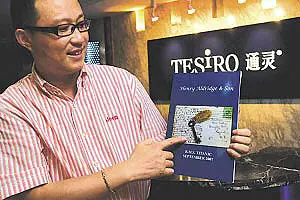
Shen Dongjun, the CEO of jewelry retailer TESIRO’s Chinese division,
the new owner of Blair's key (Image: China.com)
On September 22, 2007, the keys were sold to Shen Dongjun, the CEO of jewelry retailer TESIRO’s Chinese division for £90,000, and went on display in Nanjing, China.
Was Blair really at fault?
There are several issues with the accusation of negligence being leveled at Blair:
1. Crows Nest Key - not for Binoculars
Firstly the key seen at auction clearly reads "Crows Nest Key" and in Hogg's testimony he clearly says that the binoculars were locked up in the Second Officer's cabin - not the Crow's Nest.
Aldridge however stated at the auction that the keys were "used on the crows nest, or the binoculars locker also on the crows nest, mentioned by lookout, Fleet, in his official enquiry evidence." But where is the evidence of a "binoculars locker also on the crows nest"?
Actually, Lookout Frederick Fleet stated at the US Inquiry "They said there was none intended for us." If they were sitting in a locker would Fleet have said there were "none" aboard? Also Fleet gave further details based on the Oceanic and that they were not kept in the Crow's Nest, at the British Inquiry::
When you were in the "Oceanic" and employed there as the look-out, did you have glasses?
- Yes.
17371. Glasses provided for you in the crow's-nest?
- Yes; every trip.
17372. Were they kept in the crow's-nest?
- No; at the end of the voyage we took them back to the second Officer.
17373. But whilst on the voyage they were kept somewhere in the crow's-nest?
- Yes, in a bag.
And later...
17409. (The Commissioner.) Did you know at the time you went into the crow's-nest, which was at 10 o'clock that night, that there were no glasses in the box or bag? Did you know that?
- I knew that as soon as we left Southampton.
Charles Bartlett, Marine Superintendent of the White Star Line, testified at the British Inquiry, that the small "box" in the port corner was not just for binocolars:
21715. (Mr. Scanlan.) Why have you a bag or a box in the crow’s nest to hold binoculars if you do
not think they are required?
-That was not always for binoculars; that was for anything the men used in the look-out.
21716. It was not always for binoculars, but it was for anything a man might use on the look-out,
you say?
-Yes.
21717. What do you mean by that?
-His muffler, his clothes, and his oilskin coat and that sort of thing. There is generally a canvas bag put up there.
It must also be noted that there was undoubtedly more than one set of keys aboard the ship.
For example, the Daily Mail printed a photograph on the 15th of March 2018 showing "the keys before they were restored for auction. Pictured is a label which clearly reads 'binocular box.'"" This second set of keys with the label "binocular box" were originally owned by Peter Boyd-Smith, founder of Southampton-based specialist dealer, Cobwebs, and were also later sold at auction in 2010 ("Titanic key that could have saved the ship goes on sale", The Express, April 16, 2010). The Henry Alridge & Son listing that accompanied the sale explained that there are "four keys on a double ring and brass tag with punched lettering 'Binocular Box' One key belonged to the binocular box on the bridge... and it is unknown where the other three were used."
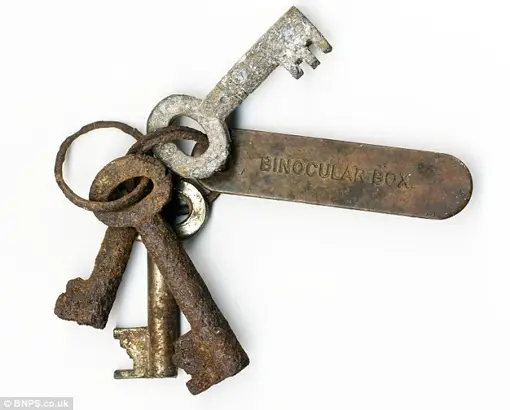
The Daily Mail printed a photograph in 2018 of the other set of keys 'before they were restored for auction' showing a label which reads 'binocular box.'
So we can conclude that binoculars were not locked in the Crows Nest.
2. Lightoller had binoculars
Lightoller who took over Blair's cabin as Second Officer, never mentions not being able to open a locker in his cabin. Also neglected in any media discussion is the fact that there were binoculars on the bridge - so Titanic indeed did have a pair of "glasses". However Lightoller did not deem them of use to the lookouts. During the British Inquiry, Lightoller noted that they had binoculars on the bridge "a pair for each senior officer...and the Commander, and one pair for the bridge, commonly termed pilot glasses."
Fleet even admitted to knowing this:
Senator SMITH. Do you know whether the officer on the bridge had glasses?
Mr. FLEET. Yes, sir.
Senator SMITH. Did you see him using them?
Mr. FLEET. Yes, sir.
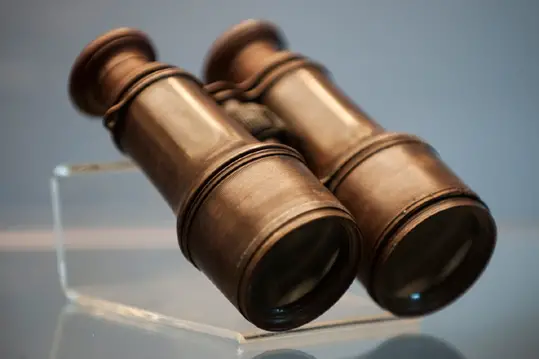
Binoculars recovered from the Titanic wreck. Some sources, such as the Shutterstock library, claim they were recovered from the Crows Nest.
3. Bincoulars not used to sight objects
Frederick Fleet famously said at the US Inquiry when asked about glasses:
Senator SMITH. Suppose you had had glasses such as you had on the Oceanic, or such as you had between Belfast and Southampton, could you have seen this black object a greater distance?
Mr. FLEET. We could have seen it a bit sooner.
Senator SMITH. How much sooner?
Mr. FLEET. Well, enough to get out of the way.
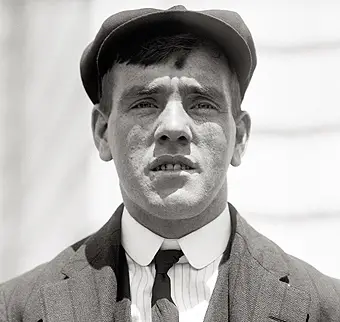
Lookout Frederick Fleet actually admitted that they
would only use binoculars after spotting an object:
"then we would have the glasses to make sure".
This is what the media repeated in the case of Blair's keys. However the more important part of his testimony that is not mentioned is the following:
Senator BURTON. Suppose you had those glasses; would you have them to your eyes most of the time, using them?
Mr. FLEET. No; no.
Senator BURTON. What part of the time?
Mr. FLEET. If we fancied we saw anything on the horizon, then we would have the glasses to make sure.
At the British Inquiry Fleet was also pushed on this matter and eventually stated:
Sir ROBERT FINLAY. Do you agree with this. This is what Symons says: “You use your own eyes as regards the picking up anything, but you want the glasses then to make certain of that object.” Do you agree with that?
Fleet - Yes.
The other lookouts also agreed:
Do you mean you believe in your own eyesight better than you do in the glasses?
Yes.
– George Hogg (B17518)
As a rule, do I understand you prefer to trust your naked eye to begin with?
Well, yes, you trust your naked eye.
– George Symons (B11994)
This was not just Fleet and Hogg's opinion, but confirmed in other testimony during the inquiries:
Do you think it is desirable to have them?
No, I do not.
Captain Richard Jones, Master, S.S. Canada (B23712)
We have never had them.
Captain Frederick Passow, Master, S.S. St. Paul (B21877)
I would never think of giving a man in the lookout a pair of glasses.
Captain Stanley Lord, Master, S.S. Californian (U. S. Day 8)
I have never believed in them.
Captain Benjamin Steele, Marine Superintendent at Southampton
for the White Star Line (B21975)
“Did not believe in any look-out man having any glasses at all.”
Antarctic explorer Sir Ernest Shackleton
1846. They are a source of danger, Sir. They spoil the look-out.
21847. How is that?
The look-out man when he sees a light if he has glasses is more liable to look at it and see what kind of a ship it is. That is the officer’s business. The look-out man’s business is to look out for other lights.
Captain Bertram Hayes, Master of the White Star Line’s Adriatic
Second Officer Lightoller when he was asked if binoculars would not have helped the lookouts identify what they saw as an iceberg sooner, replied: “He might be able to identify it, but we do not wish him to identify it. All we want him to do is to strike the bells.” (B14293)
According to legal expert Gary Slapper, Blair's "forgetfulness wasn’t a material reason for the disaster" as there were other intervening causes. (Gary Slapper, September 5, 2007, "The Law Explored: the law of causation". The Times, London).
From all of this we can conclude that Blair has been unfairly blamed for taking that which could have allegedly "saved" Titanic. Firstly, it does not seem the key would have opened anything that would contain binoculars as they were not kept in the crow's nest. Titanic already had binoculars onboard anyway, and even if the lookouts had a pair of "glasses" they still would have firstly used their naked eye to spot an object before confirming its identity. So Blair's key has little-to-no bearing on the tragedy.
It is my opinion that sadly a man's reputation has been besmirched to increase an object's value at auction.
See also...
Next... Majestic Hero